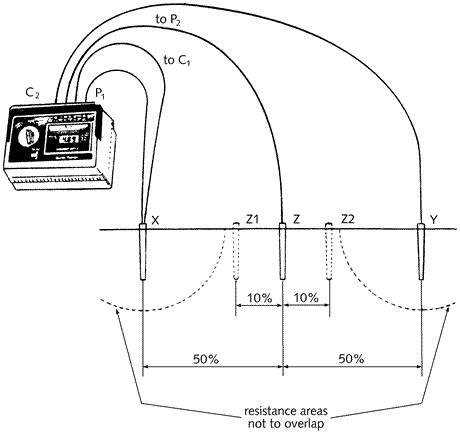Ground ring ground rods.
Ground rod resistance check.
If there were 60 similar ground electrodes with a resistance of 10 ω each the measurement of the total loop resistance would be.
Check your clamp on tester s manual if it uses another kind of configuration.
Unfortunately as time goes by factors such as ground rod corrosion soil moisture high salt content high temperatures and loss of contact of your wires as well as others may increase the resistance of ground rod s hence affecting its effectiveness.
In areas where driving ground rods may be impractical the two point method can be used.
The lower it is the better job it does.
For instance if a ground rod is driven into a very rocky and dry area it may not conduct electricity into the ground well.
In some instances ground rods can be installed in areas where the earth has a lot of resistance.
P2 and c2 connect to a separate all metallic grounding point like a water pipe or building steel.
Run the wire to your test location.
Ideally a ground should be zero ohms of resistance but.
An ideal ground rod resistance should be below 3 ohms.
So if you are using 10 foot ground rods you must place.
R loop 10 ω 0 17 ω 10 17 ω.
Unfortunately there is not one standard ground resistance threshold recognized by all certifying agencies.
If your ground rods are placed at least one rod length apart you can use a formula to estimate the earth resistance of multiple grounding rods.
To properly test the resistance of a ges you must follow some simple rules.
You should measure the resistance of an electrode with respect to the surrounding soil in the area.
However we can estimate the resistance to ground using scenario b.
The measurement of the loop resistance is relatively close to the resistance of the ground electrode being tested.
For a safe electrical system your ground rod resistance should have a very low resistance value.
You can only do this by using the fall of potential method with a three terminal earth ground resistance tester.
For example the national electric code requires no greater than 25 ohms of resistance in a ground system.
Step 1 connect your length of wire to a metal stake in the ground.
If this is the case for your ground rod the best solution is to drive a different rod into a different location.
With this method the resistance of two electrodes in a series is measured by connecting the p1 and c1 terminals to the ground electrode under test.
The nfpa and ieee recommend a ground resistance value of 5 ohms or less while the nec has stated to make sure that system impedance to ground is less than 5 ohms specified in nec 50 56.

